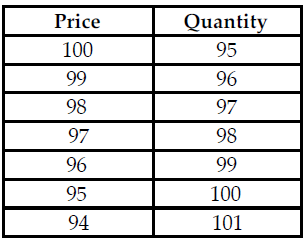Why do human femora (thighbones) angle toward each other from the hip to the knee ("knee-in")?
a. The femora are angled so that foot stance of humans can be wider than the pelvis width.
b. They structurally orient the body from a wider pelvis to more narrowly spaced feet.
c. They shift support of the upper body onto the knees.
d. They shift the weight of the upper body onto the arched feet.
e. The femora do not angle toward each other? they are vertically straight and the tibia are angled.
b
You might also like to view...
Refer to the table below. What is the monopolist's marginal revenue of the 96th unit?

The above table shows a sample of prices and the quantity sold by a monopolist.
A) -$4
B) $4
C) $8
D) $9,504
The best archaeological support is given to the extinction scenario
Indicate whether the statement is true or false
Kwang-chih Chang has linked the development of civilization in China to:
a. the restricted access to the means of communication b. the development of irrigation systems c. the emergence of agriculture d. extended periods of cold and dry weather e. the emergence of efficient transportation systems
Nuclear families risk what?
a. Economic extinction b. Disintegration c. social isolation d. Economic dependence